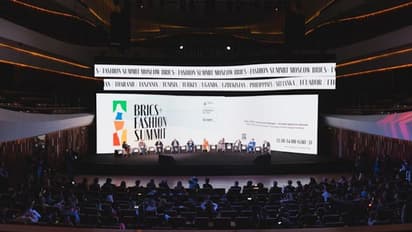BRICS+ Fashion Summit Rings in Global Equality and Devolution Call in Fashion Industry

Synopsis
The Summit underscored major strides for nations that previously grappled with establishing their footprint in the fashion sphere. Industry pundits outlined an ambitious blueprint for fostering reciprocal collaborations, focusing on the pressing need for industry globalization and decentralization.
The curtains have just been drawn on the recent BRICS+ Fashion Summit in Moscow, a stage where industry stalwarts from India, China, Pakistan, Iran, the United Arab Emirates, and a panorama of 55 other nations convened. The crux of their discourse centered around a compelling call for democratization and decentralization within the global fashion milieu.
The event saw a notable presence of representatives from blossoming fashion markets spanning Latin America, Africa, the Middle East, Southeast Asia, and the Commonwealth of Independent States (CIS). This first-of-its-kind international fashion forum extended a unique opportunity to nations often eclipsed on the global fashion stage to articulate their significance and flex their burgeoning influence.
The Spotlight on Diversity
Renowned South African designer David Tlale, whose collections have graced the marquees of Paris and New York Fashion Weeks, shared an enriching perspective on his country's fashion landscape during the BRICS+ Fashion Summit. About South Africa’s fashion industry, Tlale reflected, "We're unfettering ourselves from the vestiges of the past. We are affirming our identities and standing confidently." Tlale not only contributed to the engaging discourse, but his collection, weaving together contemporary trends with indigenous motifs, enthralled attendees. Tlale's mission seamlessly dovetails with that of local brands—to bask in their cultural heritage and traditions while radiating their brilliance on the global stage.
Hany El Behairy, a name synonymous with Egyptian-inspired fashion, offered another remarkable highlight at the summit. El Behairy, who holds the distinction of designing the priciest wedding dress in Egypt's fashion annals, spellbound the audience with his collection of opulent evening gowns festooned with feathery and crystalline details. The show opened with a dress adorned plentifully with sparkling crystals, a stunning homage to the legendary Egyptian Queen Nefertiti. Complementing these couture creations were accessories like headpieces and jewelry, anchored in traditional Ancient Egyptian motifs, melding history and contemporary design sensibilities.
The fashion brand Kunjina, hailing from Ethiopia, also debuted its collection, offering a fresh take on women's wardrobe staples. Kunjina Tesfaye, the label's founder, demonstrated her flair for avant-garde fashion, with a predilection for asymmetry and structural elements, while anchoring her designs in a soothing pastel-color palette. Traditional elements were integrated effortlessly into each creation, with the incorporation of red lines and ethnic graphics providing a unique flair. Initially catering to a close-knit circle of friends and family, Kunjina is now making waves on the global stage, garnering well-deserved recognition and acclaim.
A Fusion of Cultures, a Stage for Global Partnership
The BRICS+ Fashion Summit unfurled as a vibrant tableau of cultural fusion, fostering what renowned South African designer, David Tlale, appropriately described as "cross-pollination." Participants conscientiously revealed glimpses of their countries' traditions and experiences, reflected vividly in their selection of national garb, use of vernacular tongues during dialogues, and infusion of identifiable cultural motifs into their wardrobes. This reciprocal interchange of ideas is envisaged to nourish the global fashion industry and pave the way for robust collaborations among nations.
Adama Amanda Ndiaye, the brainchild behind Senegal's celebrated Dakar Fashion Week, lauded this platform for what she aptly termed "creative travel." Ndiaye underscored the pivotal role this engenders in propelling industry growth and creating invaluable opportunities for international networking. Industry experts were given a rare insight into nascent markets, helping them pinpoint potential goldmines and forge alliances for future collaborations.
Running concurrently with the Summit, the 'B2B showroom' further spurred participants' familiarity with dynamic markets. Collections from over 100 Russian brands and 30 international market leaders, including the likes of China, Brazil, India, Argentina, Nigeria, and Turkey, were on display. This immersive experience unveiled the latest novelties in fashion to buyers, and provided brand founders and designers an opportunity to exchange wisdom, scale their output and, more significantly, identify prospective clientele. Even post-event, the buzz around potential deals and possible collaborations perpetuated.
Revamping the Dynamics of Fashion Influence
The Summit underscored major strides for nations that previously grappled with establishing their footprint in the fashion sphere. Industry pundits outlined an ambitious blueprint for fostering reciprocal collaborations, focusing on the pressing need for industry globalization and decentralization. In this more inclusive vision, joint ventures and worldwide platforms find a central role, set to empower the BRICS+ countries to exert a substantial influence on international fashion and cement their positions as powerhouses in the fashion realm.
In the eloquent words of South African designer David Tlale, organizing an event of the caliber of the BRICS+ Fashion Summit is a testimony to the remarkable shifts happening on the global fashion platform. The traditional game is changing, and it's time the world applauds the incredible talent and noteworthy contributions rising from regions that have traditionally been sidelined in the fashion narrative.